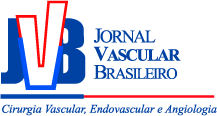Lipectomia como alternativa de superficialização de fístula arteriovenosa autóloga em pacientes obesos: a experiência de um centro de referência na Amazônia
Lipectomy as an alternative for superficialization of autologous AVF in obese patients: experience of a referral center in Amazon
José Maciel Caldas dos Reis; Flávio Roberto Cavalleiro de Macêdo Ribeiro; Glauco dos Santos Melo; Humberto Balbi Reale Neto; Mariseth Carvalho de Andrade
Resumo
Palavras-chave
Abstract
Background: The preferred vascular access for hemodialysis is a native arteriovenous fistula (AVF) because it offers the best results in the short and long terms, lower morbidity and mortality, and has additional advantages in relation to central venous catheters or arteriovenous grafts. However, obesity can present an additional challenge because of the barrier of subcutaneous cellular tissue covering the surface of the vein to be punctured.
Objectives: The authors review their experience with excision of subcutaneous tissue (lipectomy) overlying upper arm cephalic vein arteriovenous fistulas in obese patients
Methods: Consecutive vascular access patients undergoing lipectomy for cannulation with difficult access because of vein depth were reviewed. Cephalic vein depth was measured by ultrasound in all cases
Results: Twenty-two patients were reviewed (15 men and 7 women), with a mean body mass index of 34.0 kg/m2 (range: 28-40 kg/m2 ). Mean age was 58.4 years. The mean preoperative vein depth of 7.9 mm (range: 7.0-10.0 mm) was reduced to 4.7 mm (range: 3.0- 6.0 mm) (P 0.01). The mean follow-up period for patients was 13.2 months. Four patients were lost to follow-up and four died during the period due to causes unrelated to vascular access
Conclusions: Obesity should not be a limiting factor to creation of a native AVF, since lipectomy is a relatively simple option for superficialization, enabling functioning native and deep arteriovenous fistulas in obese patients.
Keywords
References
1 Balaz P, O’Neill S. Liposuction is not just an aesthetic surgery procedure. Eur J Vasc Endovasc Surg. 2019;58(5):761.
2 Roberts C. Saving a brachiocephalic fistula using lipectomy. Nephrol Nurs J. 2005;32(3):331. PMid:16035473.
3 Vanholder R. Vascular access: care and monitoring of function. Nephrol Dial Transplant. 2001;16(8):1542-5.
4 Barnard KJ, Taubman KE, Jennings WC. Accessible autogenous vascular access for hemodialysis in obese individuals using lipectomy. Am J Surg. 2010;200(6):798-802.
5 Silva GB Jr, Bentes ACSN, Daher EDF, Matos SMA. Obesidade e doença renal. Braz. J. Nephrol. 2017;39(1):65-9.
6 Tordoir JH, van Loon MM, Peppelenbosch N, Bode AS, Poeze M, van der Sande FM. Surgical techniques to improve cannulation of hemodialysis vascular access. Eur J Vasc Endovasc Surg. 2010;39(3):333-9.
7 Schmidli J, Widmer MK, Basile C, et al. Editor’s choice - vascular access: 2018 clinical practice guidelines of the European Society for Vascular Surgery (ESVS). Eur J Vasc Endovasc Surg. 2018;55(6):757-818.
8 Cs Nagy G, Verwiebe R, Wunsch M. Staged ultrasound-guided liposuction for hidden arteriovenous fistulas in obese patients. Vasa. 2018;47(5):403-7.
9 Ibeas J, Roca-tey R, Vallespin J, et al. Guia clínica espanola del acesso vascular para hemodiálise. Nefrologia. 2017;37(1):1-192.
10 Elbarbary AH. One-stage lipectomy superficialization of deep cephalic veins in comparison with secondary lipectomy in arteriovenous dialysis fistula. J Vasc Access. 2019;20(4):374-9.
11 Jennings WC, Galt SW, Shenoy S, et al. The Venous Window Needle Guide, a hemodialysis cannulation device for salvage of uncannulatable arteriovenous fistulas. J Vasc Surg. 2014;60(4):1024-32.
12 Bourquelot P, Tawakol JB, Gaudric J, et al. Lipectomy as a new approach to secondary procedure superficialization of direct autogenous forearm radial-cephalic arteriovenous accesses for hemodialysis. J Vasc Surg. 2009;50(2):369-74, 374.e1.
13 Triola MF. Introdução à estatística. 12ª ed. Rio de Janeiro: LTC; 2017.
14 Miot HA. Tamanho da amostra em estudos clínicos e experimentais. J Vasc Bras. 2011;10(4):275-8.
15 Friedman AN, Kaplan LM, le Roux CW, Schauer PR. Management of obesity in adults with CKD. J Am Soc Nephrol. 2021;32(4):777-90.
16 Wang Y, Beydoun MA, Liang L, Caballero B, Kumanyika SK. Will all Americans become overweight or obese? Estimating the progression and cost of the US obesity epidemic. Obesity. 2008;16(10):2323-30.
17 Maliska MC 3rd, Jennings W, Mallios A. When arteriovenous fistulas are too deep: options in obese individuals. J Am Coll Surg. 2015;221(6):1067-72.
18 Sułkowski L, Matyja M, Pasternak A. Lipectomy technique as a second-stage procedure for primarily matured, deep outflow vein in obese individuals. Indian J Nephrol. 2018;28(4):320-2.
19 Tasopoulou KM, Argyriou C, Kakkos SK, et al. Superficialization methods of arteriovenous fistula in obese patients: a review of the literature. Ann Vasc Surg. 2022;83:313-27.
20 Weyde W, Krajewska M, Letachowicz W, et al. Obesity is not an obstacle for successful autogenous arteriovenous fistula creation in haemodialysis. Nephrol Dial Transplant. 2008;23(4):1318-22.
21 Weyde W, Krajewska M, Letachowicz W, Klinger M. Superficialization of the wrist native arteriovenous fistula for effective hemodialysis vascular access construction. Kidney Int. 2002;61(3):1170-3.
22 Bourquelot P, Karam L, Robert-Ebadi H, Pirozzi N. Transposition, elevation, lipectomy and V-Wing for easy needling. J Vasc Access. 2015;16(Suppl 9):S108-13.
23 Hill AA, Vasudevan T, Young NP, et al. Use of an implantable needle guide to access difficult or impossible to cannulate arteriovenous fistulae using the buttonhole technique. J Vasc Access. 2013;14(2):164-9.
24 Zeindler J, Richarz S, Francini M, Soysal S, Gürke L, Isaak A. Endoscopic superficialisation of haemodialysis arteriovenous fistulas in obese patients e safety, feasibility and outcomes. Eur J Vasc Endovasc Surg. 2019;58(5):756-60.
25 Isaak A, Schlunke S, Stierli P, Gürke L. Endoscopic superficialization of arteriovenous fistula: a novel technique with common devices. Ther Apher Dial. 2018;22(5):556-8.
Submitted date:
04/06/2023
Accepted date:
01/06/2024



